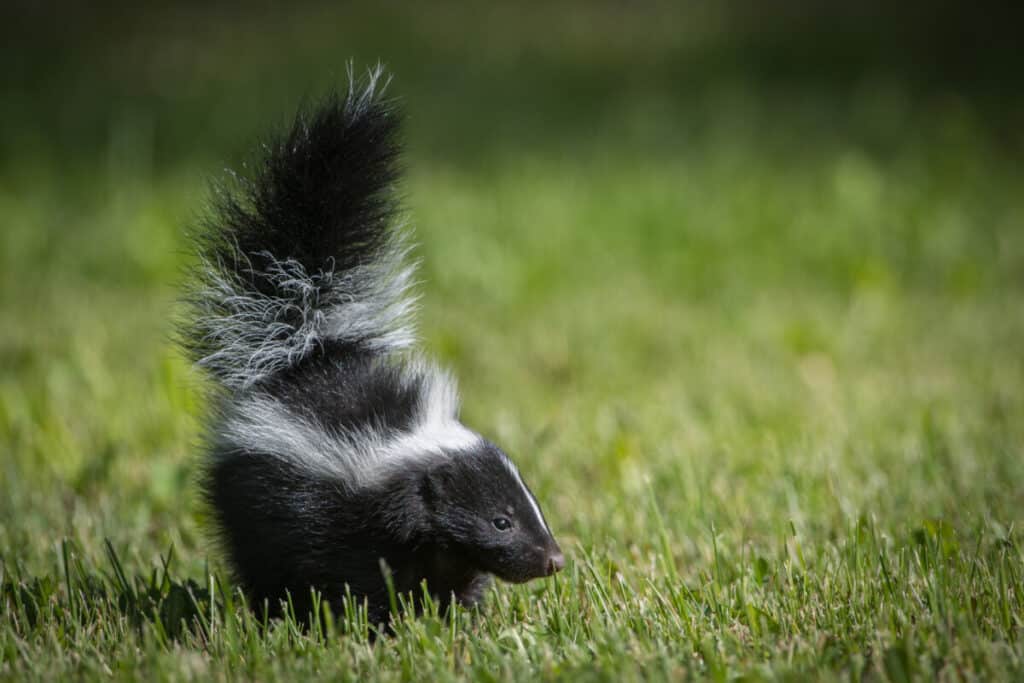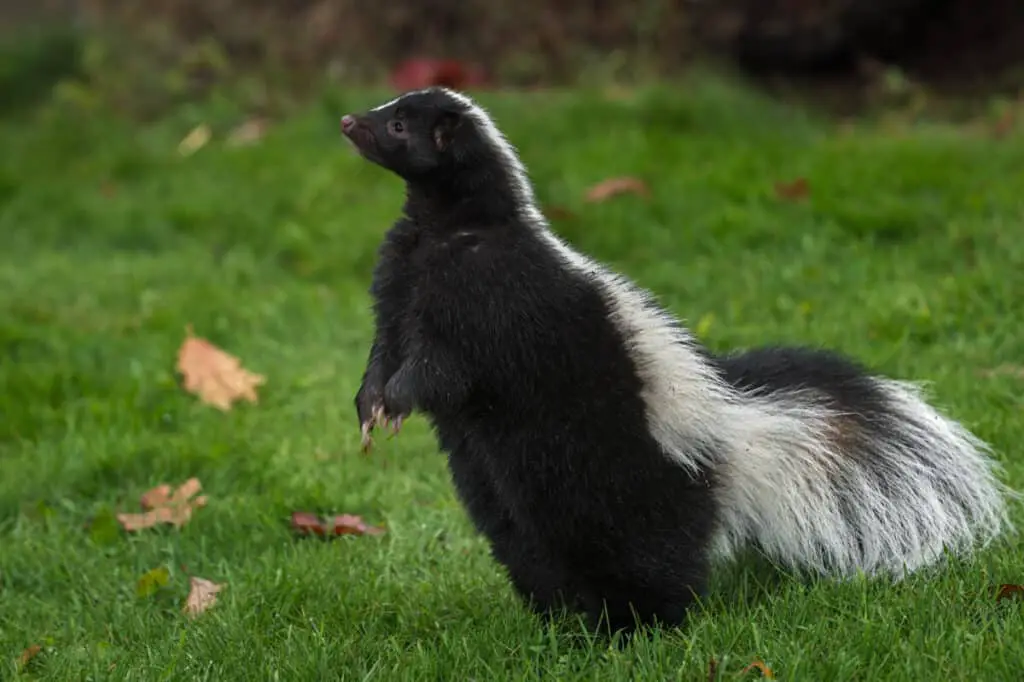Skunks are a species of mammal found in many parts of the world. They are characterized by their unique black and white fur coloration, as well as their musky scent glands which can be used for defense when threatened.
This article will explore further skunk characteristics, with an emphasis on behavior and anatomy.
Skunks belong to the family Mephitidae, which includes other small carnivores such as badgers, otters, weasels and mongooses. All members of this family share certain traits including long snouts and short legs.
Skunks also have some distinct anatomical features that make them stand out from other animals – they possess two large scent glands located near the anus that produce a noxious odour when released into the air. This is often used as a defensive mechanism against predators or threats.

Behavior
Skunks are recognized for their extraordinary personalities and behaviors. Research shows that skunks live in social groups of up to 12 individuals, with the dominant pair claiming a territory of approximately 500 square meters.
The territoriality exhibited by these animals is largely driven by food resources and mating habits; they typically mark their territories using urine or feces as scent markers while also making use of different vocalizations when defending it from intruders.
Skunks display a range of other interesting behaviors such as digging burrows, sunbathing, and even playing games like tag with one another.
Moreover, recent studies have revealed that skunks may possess some degree of self-recognition ability – meaning they can recognize themselves in mirrors just like primates do.
These fascinating creatures clearly demonstrate an array of unique traits which make them especially intriguing to study.
Anatomy
Skunks are well-known for their defensive behavior, which is typically an odoriferous spray produced by two scent glands located near the anus.
While this defense mechanism is highly effective in deterring predators, skunks also employ other strategies to avoid unwanted attention from potential predators.
During mating season, male skunks engage in a variety of courtship rituals that can involve spraying and fighting with one another; these behaviors serve as warnings to any nearby predators.
Additionally, skunks have excellent senses of hearing and smell, allowing them to detect danger before it gets too close.
They rely on these heightened senses along with rapid movements to quickly flee from any potential threats.
Skunks use camouflage as another means of predator avoidance; they often blend into their surrounding environment using a combination of fur coloration and posturing.
In some cases, such as when threatened by large birds or mammals, skunks will stand up on their hind legs and spread out their front claws while arching their back in order to make themselves appear larger than they actually are.
This serves as an intimidating posture that warns off most predators without requiring physical contact.
Scent Glands
Skunks are renowned for their ability to defend themselves from predators. Their infamous black and white fur is the most recognizable characteristic of skunks, but it isn’t their only defense. Skunks have scent glands that contain a powerful musk which they can release when threatened:
- Defensive spray used as predator avoidance
The defensive spray released by skunks has been found to be capable of deterring potential predators from attacking them due to its pungent odor and burning sensation upon contact with skin or eyes.
- Communication in mating rituals
Additionally, this same chemical cocktail serves an important role during mating rituals between different species of skunks, where it acts as a signal to communicate reproductive readiness and other messages related to territorial dominance or submission within a given population group.
- Territorial marking
Finally, even intraspecies communication among skunks relies on scent mark signals produced by these specialized glands located around their body parts like tail, back and sides of head regions; each set conveying specific messages depending on the context at hand.
Diet
The skunk’s diet is varied and dependent on the region it inhabits. Skunks are omnivorous, meaning they feed on both plants and animals. They forage for insects, larvae, earthworms, grubs, small rodents, frogs, eggs, fruit and nuts depending on what food sources are available in their environment.
| Food Source | Common Location(s) | Benefits |
|---|---|---|
| Insects | Wooded Areas | Nutritious |
| Larvae | Meadows | Protein Rich |
| Earthworms | Forests | High In Fat & Minerals |
| Grubs | Grasslands | High Calorie Content |
| Small Rodents | Suburban Areas | Protein Rich |
Skunks commonly inhabit burrows or den sites that have been left by other species such as foxes or badgers. During summer months they may build a shallow den under fallen logs or other debris.
Their diets can vary greatly within this location range but typically consist of grasshoppers, beetles, crickets and caterpillars during spring; fruits, berries and acorns during late summer through fall; while winter diets predominantly consists of birdseed from backyard feeders when available.
In addition to these foods sources skunks will scavenge carrion (dead animal flesh), which provides them with an additional source of nutrients essential for growth and development.
Adaptations
Skunks are highly adapted animals to the natural environment. They possess a variety of physical and behavioral characteristics that allow them to survive in different habitats, from deserts to forests.
Skunks have strong social hierarchies within their species, which they use as part of their habitat selection process. The dominant skunk will choose the best site for shelter or denning, while subordinate skunks will look for alternative sites elsewhere.
Skunks also communicate with each other through scent marking and vocalizations such as growls, hisses, whines, screeches and purrs. This helps them stay safe when out in the open by alerting potential predators of their presence before any conflict arises.
Additionally, their fur is thick and oily which provides insulation against cold temperatures and protection from bites and scratches during conflicts with other animals. These adaptations give skunks an advantage over many other small mammals living in similar environments.

Conclusion
The skunk is a unique species that has adapted to live in many different environments. Its anatomy, behavior, diet and scent glands all contribute to its success as an adaptable animal.
Skunks have evolved specialized scent glands that contain thiols which produce a strong odor used for defense purposes. Surprisingly, skunks are able to spray their defensive odors accurately up to 10 feet away with remarkable accuracy! This fascinating fact demonstrates the skillful capabilities of this resilient species.
The diet of the skunk typically consists of small animals such as mice, insects, and berries. Adaptations include having thick fur to ward off predators and long claws for digging up food from beneath the ground.
As humans continue to encroach on wildlife habitats around the globe, it is important that we recognize and appreciate these creatures for the amazing adaptations they possess.

